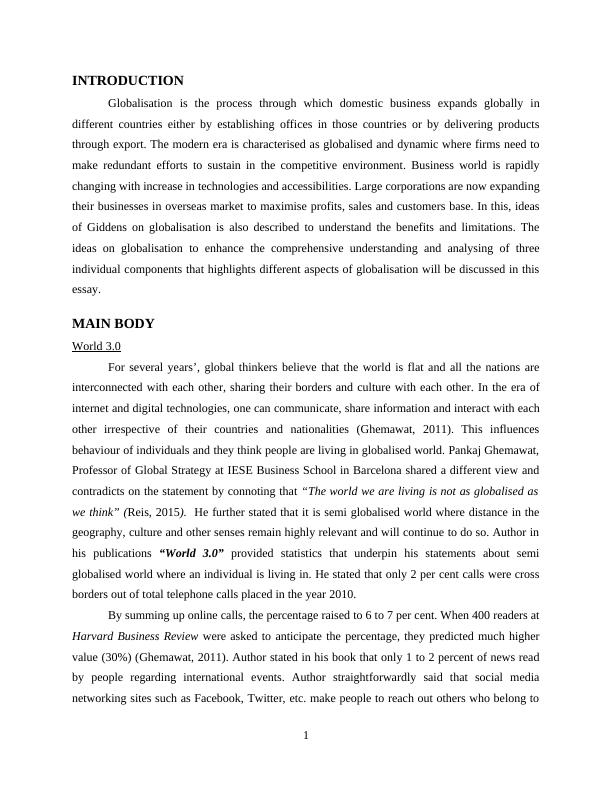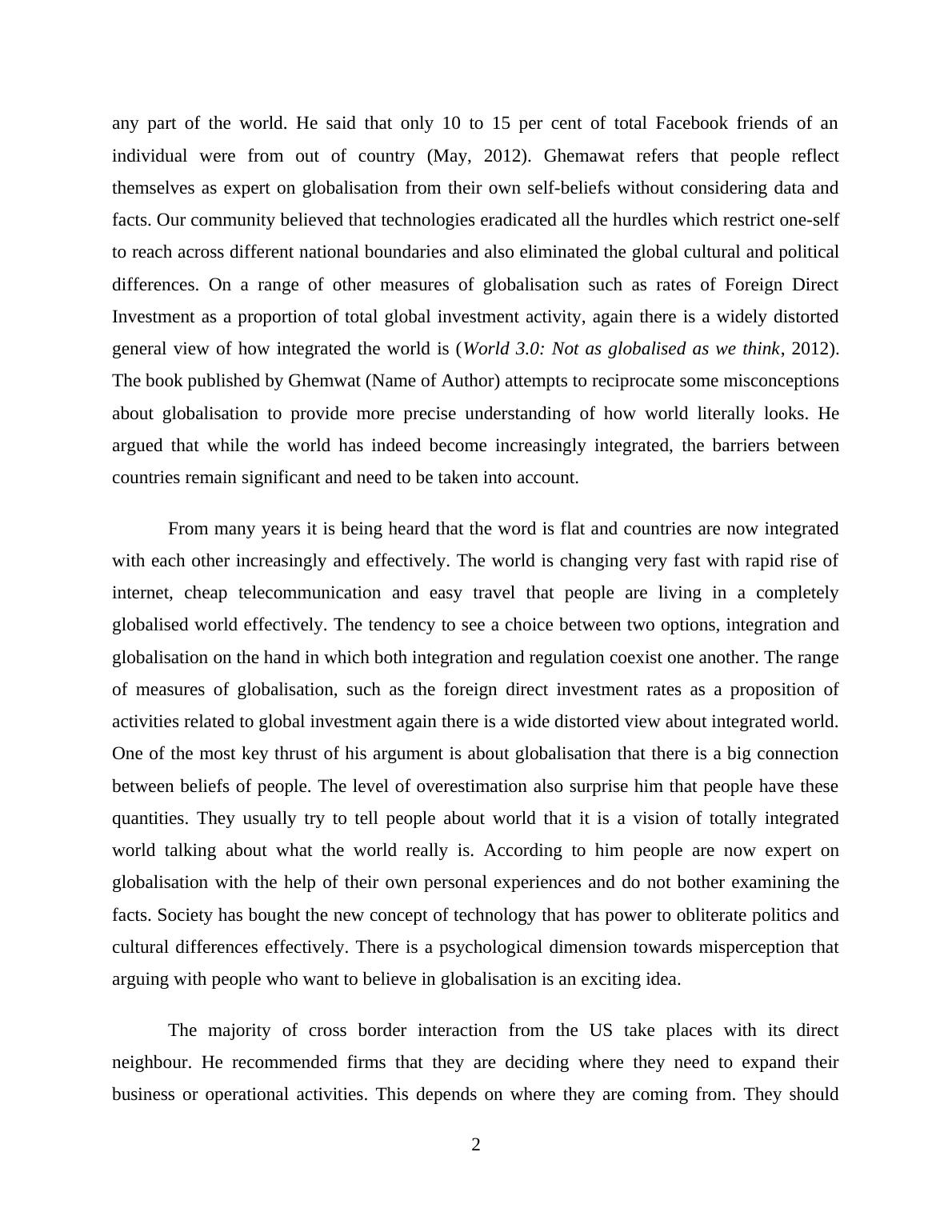Anthony Giddens Ideas on Globalisation
12 Pages3794 Words77 Views
Added on 2020-10-05
Anthony Giddens Ideas on Globalisation
Added on 2020-10-05
ShareRelated Documents
MOG PROJECT

TABLE OF CONTENTSINTRODUCTION...........................................................................................................................1MAIN BODY...................................................................................................................................1World 3.0.....................................................................................................................................1Anthony Giddens’ ideas on globalisation. .................................................................................2The “End of Poverty” movement and the contrary assertion that “Trade NOT aid” is the wayto a more globalised world that mitigates against poverty..........................................................3CONCLUSION................................................................................................................................4REFERENCES................................................................................................................................5

INTRODUCTIONGlobalisation is the process through which domestic business expands globally indifferent countries either by establishing offices in those countries or by delivering productsthrough export. The modern era is characterised as globalised and dynamic where firms need tomake redundant efforts to sustain in the competitive environment. Business world is rapidlychanging with increase in technologies and accessibilities. Large corporations are now expandingtheir businesses in overseas market to maximise profits, sales and customers base. In this, ideasof Giddens on globalisation is also described to understand the benefits and limitations. Theideas on globalisation to enhance the comprehensive understanding and analysing of threeindividual components that highlights different aspects of globalisation will be discussed in thisessay.MAIN BODYWorld 3.0For several years’, global thinkers believe that the world is flat and all the nations areinterconnected with each other, sharing their borders and culture with each other. In the era ofinternet and digital technologies, one can communicate, share information and interact with eachother irrespective of their countries and nationalities (Ghemawat, 2011). This influencesbehaviour of individuals and they think people are living in globalised world. Pankaj Ghemawat,Professor of Global Strategy at IESE Business School in Barcelona shared a different view andcontradicts on the statement by connoting that “The world we are living is not as globalised aswe think” (Reis, 2015). He further stated that it is semi globalised world where distance in thegeography, culture and other senses remain highly relevant and will continue to do so. Author inhis publications “World 3.0” provided statistics that underpin his statements about semiglobalised world where an individual is living in. He stated that only 2 per cent calls were crossborders out of total telephone calls placed in the year 2010. By summing up online calls, the percentage raised to 6 to 7 per cent. When 400 readers atHarvard Business Review were asked to anticipate the percentage, they predicted much highervalue (30%) (Ghemawat, 2011). Author stated in his book that only 1 to 2 percent of news readby people regarding international events. Author straightforwardly said that social medianetworking sites such as Facebook, Twitter, etc. make people to reach out others who belong to1

any part of the world. He said that only 10 to 15 per cent of total Facebook friends of anindividual were from out of country (May, 2012). Ghemawat refers that people reflectthemselves as expert on globalisation from their own self-beliefs without considering data andfacts. Our community believed that technologies eradicated all the hurdles which restrict one-selfto reach across different national boundaries and also eliminated the global cultural and politicaldifferences. On a range of other measures of globalisation such as rates of Foreign DirectInvestment as a proportion of total global investment activity, again there is a widely distortedgeneral view of how integrated the world is (World 3.0: Not as globalised as we think, 2012).The book published by Ghemwat (Name of Author) attempts to reciprocate some misconceptionsabout globalisation to provide more precise understanding of how world literally looks. Heargued that while the world has indeed become increasingly integrated, the barriers betweencountries remain significant and need to be taken into account.From many years it is being heard that the word is flat and countries are now integratedwith each other increasingly and effectively. The world is changing very fast with rapid rise ofinternet, cheap telecommunication and easy travel that people are living in a completelyglobalised world effectively. The tendency to see a choice between two options, integration andglobalisation on the hand in which both integration and regulation coexist one another. The rangeof measures of globalisation, such as the foreign direct investment rates as a proposition ofactivities related to global investment again there is a wide distorted view about integrated world.One of the most key thrust of his argument is about globalisation that there is a big connectionbetween beliefs of people. The level of overestimation also surprise him that people have thesequantities. They usually try to tell people about world that it is a vision of totally integratedworld talking about what the world really is. According to him people are now expert onglobalisation with the help of their own personal experiences and do not bother examining thefacts. Society has bought the new concept of technology that has power to obliterate politics andcultural differences effectively. There is a psychological dimension towards misperception thatarguing with people who want to believe in globalisation is an exciting idea. The majority of cross border interaction from the US take places with its directneighbour. He recommended firms that they are deciding where they need to expand theirbusiness or operational activities. This depends on where they are coming from. They should2

End of preview
Want to access all the pages? Upload your documents or become a member.
Related Documents
Globalisation and its Components: An Analysislg...
|11
|842
|90
Globalisation and its Effects on Society, Economy and Politicslg...
|13
|651
|291
Management and Organization in Global Environmentlg...
|11
|1381
|52
Report - Management and Organizations in a Global Environmentlg...
|5
|615
|42
HI6005 Management & Organisations In Global Environmentlg...
|10
|1737
|141
Globalization and International Management - Assignmentlg...
|7
|1375
|103
